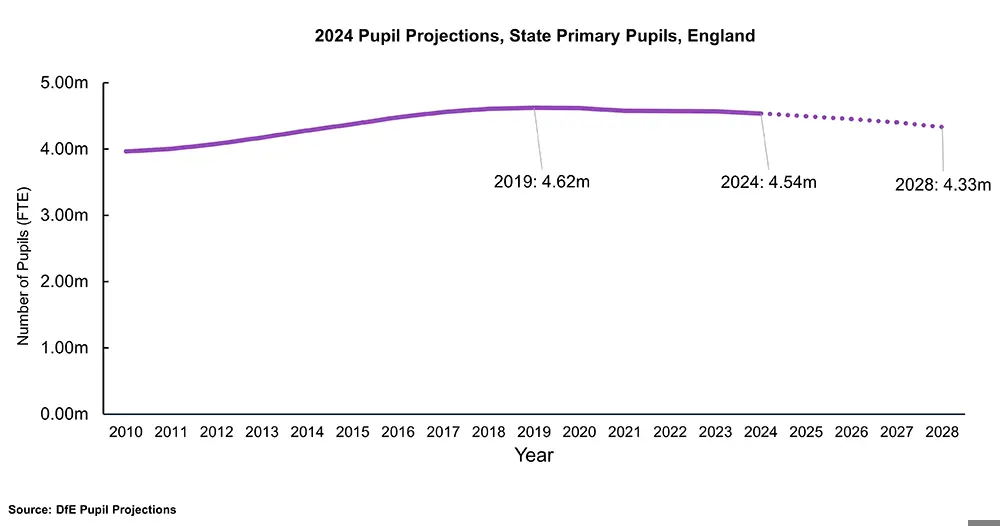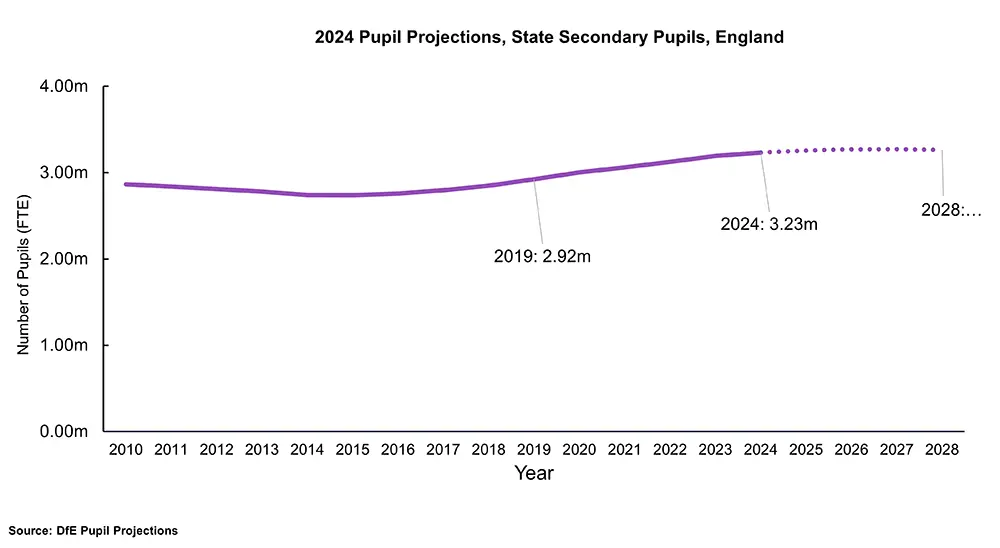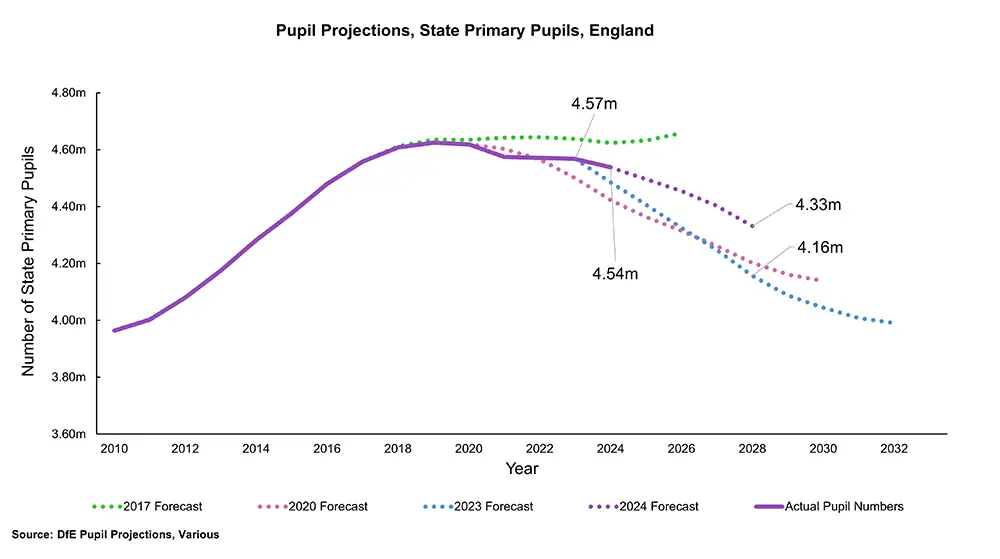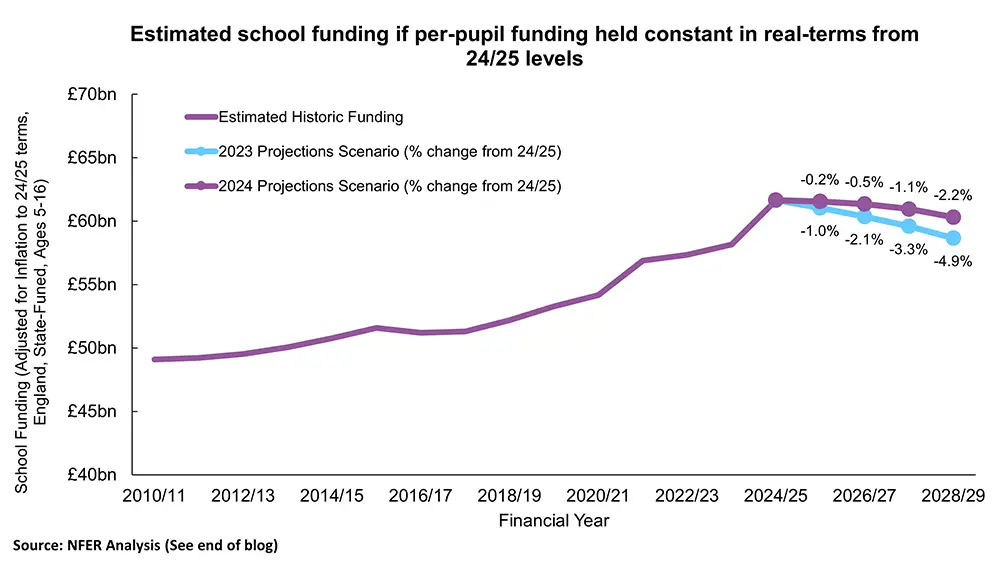“Just a little drop?” - Pupil numbers are falling slower than previous expectations
Thursday 5 September 2024
 The Department for Education (DfE) has recently revised its national pupil projections. The number of pupils in a school is very important as this impacts the amount of funding it receives, as well as the shape of the school system. The new projections now forecast a less dramatic decline in state primary pupil numbers than previously anticipated.
The Department for Education (DfE) has recently revised its national pupil projections. The number of pupils in a school is very important as this impacts the amount of funding it receives, as well as the shape of the school system. The new projections now forecast a less dramatic decline in state primary pupil numbers than previously anticipated.
In the first of three blogs, Michael Scott and Libby Tungate explore how pupil numbers are changing, how the projections are also changing, and what this all means for schools.
The number of pupils in England is changing all the time.
As of January 2024, there are around eight million pupils (aged up to 16) in state funded schools across England – 4.5 million pupils in primary, 3.2 million in secondary and the remainder in special and other types of school.
The DfE publishes annual projections on how pupil numbers are expected to change over the coming years. They published their latest projections in July 2024.
Pupil numbers are largely driven by birth rates. Primary schools see the effects of changing birth rates within a few years, whereas secondary schools have longer to respond as they can see any changes to the number of pupils as they make their way through the primary system.
The DfE is predicting a significant fall in pupil numbers by 2029, but this will play out differently in primary and secondary schools.
In primary schools, pupil numbers are falling slowly and DfE expects this to continue.

State primary pupil numbers peaked in 2018 (the 2018/19 academic year) and have been falling since then.
- From 2010 to 2019, there was a steady increase in pupil numbers in primary schools.
- Between 2019 and 2024, there was a 1.9 per cent decline, representing around 85,000 fewer pupils.
- Between 2024 and 2028, the number is projected to fall by around 4.5 per cent (205,000 pupils).
In secondary schools, pupil numbers have increased sharply since 2019, but DfE’s latest projections indicate this growth will stop soon.

State secondary pupil numbers have been rising since 2016 with the rise becoming steeper since 2019. This upward trend is projected to continue until 2027.
- Secondary pupil numbers hovered around 2.8 million between 2010 and 2018.
- Between 2019 and 2024, there was a substantial increase of around 11 per cent, (310,000 more secondary pupils).
- Between 2024 and 2028, secondary pupil numbers are projected to experience very small increases.
- Beyond 2028, DfE has projected a small fall in secondary numbers in 2029, at the end of their current forecast.
The number of pupils in the system has a wide set of implications, for funding, the workforce, and school capacity.
Pupil projections are used by government, local authorities and schools to forward plan. They are crucial in shaping funding decisions and resource allocation.
School funding is strongly linked to pupil numbers. At the system level, falling pupil numbers can create opportunities for the Government to spend less on schools whilst not reducing the amount of funding the average pupil receives. This can free up resources to spend on other priorities.
For an individual school, the funding it receives largely depends on the number of pupils.
Other things being equal, schools experiencing reduced intakes are likely to receive less funding. Schools may look to cut classes if their intake falls substantially, but it can be hard for schools experiencing smaller reductions to their intake to cut an entire class.
Schools in this position will find it difficult to reduce their staffing – which makes up the lion’s share of a school’s expenditure – and so may struggle to balance the books.
Schools experiencing these large reductions in their intake are likely to cut back on teaching or support staff by reducing recruitment and not attempting to fill vacant posts.
The impact of this, for example, could be felt in the available support for pupils with special education needs and disabilities (SEND) in mainstream schools because the proportion of pupils with SEND appears to be increasing amid the landscape of falling primary pupil numbers.
Intuitively, falling pupil numbers should mean increases in excess capacity – the number of pupils each school can accommodate – unless schools close or reduce in size.
However, the pupil projections are done on a national basis and any reasonable assessment about future capacity needs to take place at the local level. (We will explore this issue further in our third blog in this series).
Excess capacity can also create new opportunities. Labour has announced its intention to convert spare school classrooms into nursery spaces, with a target to open over three thousand new nursery classes across England.
Of course, there is a risk that if the school-age population does swing back up again or not fall as far as the projections indicate, schools may struggle to readjust to meet that need.
So, with fewer pupils in future compared to today, total government expenditure on schools could fall and some schools will have less funding. Since the bulk of a school's budget is dedicated to staffing, it is likely that it will be this area taking the hit if funding gets cut.
This could mean staff cuts, class cuts or even school closures, but this can be difficult to achieve when numbers are falling slowly.
Changing projections, changing implications?
After around a decade of primary numbers increasing, DfE started projecting a significant fall five years ago. The latest projections are far less dramatic than previously projected declines. (We have shortened the axis on this graph to show the detail of the predictions.)

In 2023, DfE projected a nine per cent decline in the number of state primary pupils from 2023 to 2028. This was largely consistent with their recent projections before 2023 too. In 2024, they reduced this to around five per cent.
This means 175,000 more primary pupils (in 2027/8) were added to the projections in 2024. The average primary school has around 275 pupils, so this is equivalent to more than 600 schools’ worth of children.
DfE say that there will be more pupils in state primary schools than they had previously forecast, although numbers will still be falling. Whilst the national fall in pupil numbers is less significant than originally thought, the implications at a local level will still be keenly felt.
The increased projection means there is less potential for the Government to save money on schools.
The DfE’s change to their projections means the most significant impacts of falling pupil numbers are likely to be less than previously thought.
To illustrate this, we estimated what would happen to overall schools funding if the Government maintained per pupil funding at the current level (adjusted for inflation). We did this for both the 2023 and 2024 pupil projections to show how the new projections make a difference:

Our model suggests that:
- Under the 2023 projections, in the 2028/29 financial year, total school funding would fall by 4.9 per cent from 2024/25, representing a saving to the Government of £3bn that year.
- However, under the 2024 projections, in 2028/29 total school funding would fall by 2.2 per cent over that same period, representing a saving of only £1.3bn.
This is only a rough estimate, and the actual figures will depend on a range of other factors, including the new Government’s decisions about funding. However, it is clear that the refreshed projections mean the Government may have less cash for other pressing priorities.
Of course, the Government could decide to use falling pupil numbers as an opportunity to improve overall levels of funding on a per-pupil basis.
Apart from funding, the current predictions still suggest that there will be a slightly lower demand for primary school places, coupled with growing excess capacity (unfilled school places) in the system.
It is unclear why the projections have changed so much recently, and therefore how much they could change again in future.
The DfE uses ONS (Office for National Statistics) population projections to produce their pupil projections along with other statistical measures such as the participation rate, which measures how many school-age children are in school.
Many different factors affect the ONS projections, including births, deaths, and migration. Naturally, some of these factors (births) are more important when projecting the number of children than others.
To add further complexity, ONS revised down their overall estimate of the national population following the 2021 Census, and this particularly affected their estimate of the number of children. It is not clear how these changes are combined, which makes it difficult to pinpoint which is having the biggest effect on DfE’s pupil projections.
Such a large change in the pupil projections inevitably raises questions about whether further changes are likely. Indeed, DfE also reduced the “sell-by” date of their forecasts from nine years ahead to just four in 2024, citing heightened uncertainty beyond that point.
The Department used to publish different scenarios for the pupil population, showing how they were affected by trends in the wider population, but they have stopped publishing these.
This is a shame, because they help show that the projections are uncertain and how sure we can be that pupil numbers going in a particular direction. We think the alternative scenarios should be reinstated in future.
It would also be useful to see the projected number of four-year-olds in reception classes separated from the projections of children who are under-five. This would make future changes in cohort sizes easier to interpret.
Conclusions
The number of pupils in state schools is set to start falling slowly. Primary pupil numbers are falling significantly while secondary numbers are rising slightly, and these trends look set to hold for the next few years.
Schools affected by falling rolls are likely to reduce the number of classes and their workforce if they can, but this will often be challenging for schools to do. Furthermore, these trends will affect individual schools differently, which is why NFER is calling on the Department to provide its predictions at regional and local levels in future.
Nationally, falling pupil numbers creates opportunities for the Government to reallocate funding without harming the overall level of per-pupil funding. But the latest projections have reduced the potential windfall available.
Finally, there is significant uncertainty regarding pupil numbers which means that clear communication and insights from DfE will be particularly important. To support this, DfE should publish different scenarios when they release pupil projections.
If this blog was of interest to you, please look out for the next two in this series. The next blog will look at areas where pupil numbers have already fallen and how schools have appeared to respond in those places. We’ll then review how Local Authority’s projections and capacity plans vary.
Note on School Funding Modelling
We adapted DfE’s School Funding Statistics, last published in January 2024 (covering data up to the 2024/25 financial year) to include more recent funding announcements for the teachers’ pension scheme and the teachers’ pay.
We use the latest OBR projections for the GDP deflator to express these in 2024/25 terms. We then project per-pupil funding rates forward from 2024/25 into future financial years.
DfE’s pupil projections and the school funding statistics do not exactly match, so we use the trend from the pupil projections to estimate changes to overall school funding under the assumption that per-pupil rates stay fixed.
